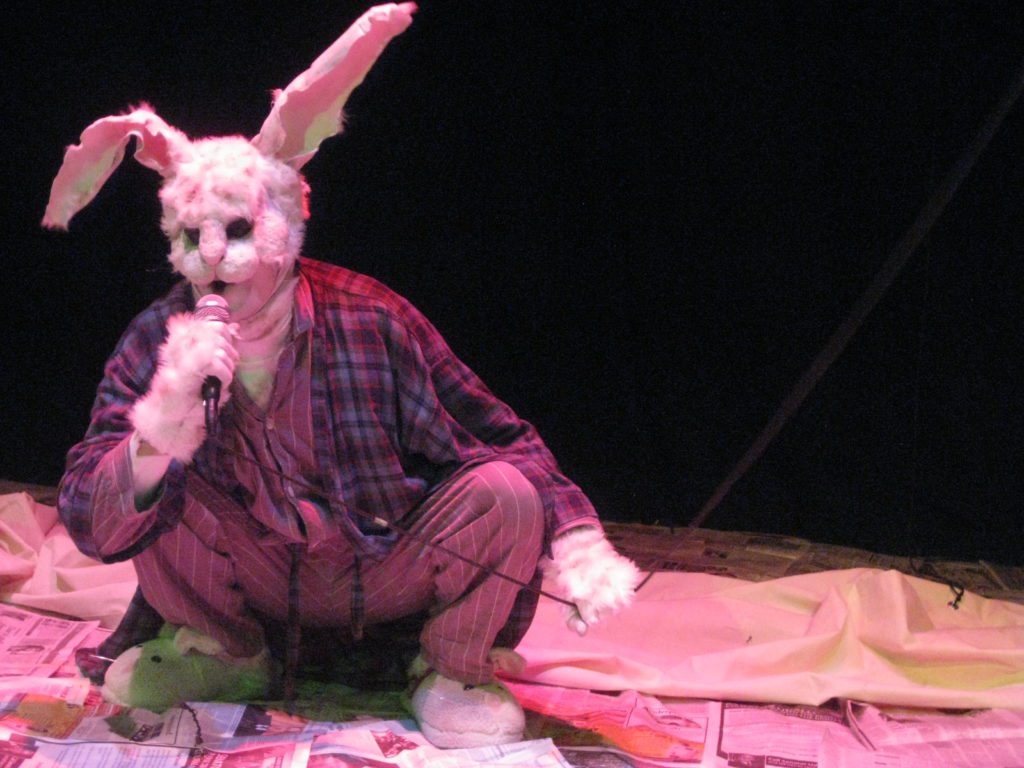When I first attended a Buntport Theater Company production and found six people in the audience – myself and my friend two of them – I’d never have predicted that the troupe would make it ten years. Other smart and talented companies have fallen by the wayside, but the six Buntporters, who met at Colorado College, moved to Denver and create all their material collaboratively, just keep on going. For this anniversary season, they’ve chosen to remount some past productions and do staged readings of a couple of others. Some might see this as a copout or a year-long semi-vacation – and I’m sure it’s partly that. But it’s also an opportunity for the members to examine past material and get a sense of where they might yet go. And for viewers who haven’t yet experienced their quirky, experimental brand of theater, it’s a chance to catch up.
The company has done a lot of exploring in ten years. Buntport has created spoofs of well-worn genres; rock musicals; horror; a serious, low-key domestic play; and another that’s upside-down political. Everything it does testifies to the power inherent in objects – which sometimes become people – as well as the crazy malleability of the physical universe and the centrality of the actor, who creates entire new realities with nothing but his mind, voice and body. The sets are cheap and inventive, the scripts a mix of brilliance and silliness. Among the shows Buntport will reprise this year are Seal. Stamp. Send. Bang., a ridiculously funny takeoff on the postal system; Winter in Graupel Bay, a bittersweet evocation of small-town life; The 30th of Baydak, which reminds us of the grim reality of life under dictatorship; and perhaps my favorite Buntport show ever, Kafka on Ice, a play I thought would never come back because some nasty human had stolen the artificial ice on which the action takes place.
The first revival, Moby Dick Unread, opened last week. The inspiration is literary, and the tone veers dangerously between satire and homage. Someone in the troupe – or perhaps everyone – loves Melville and wanted to spend weeks immersed in his great novel. But what caught Buntport’s attention was not the overarching story of Captain Ahab and his nemesis, but all the quirks and diversions. Where producers usually streamline novels, the Buntporters focused on Melville’s disquisitions about carpentry, whether the whale is or isn’t a fish, Garnery’s paintings of whales and whaling, and the difference between a fast and a loose fish. They found humor in Moby Dick, and also moments of poignance – such as Pip’s near-drowning and subsequent madness. Inevitably, this means there’s a shagginess, even formlessness, to the production, but it’s faithful to the discursive nature of the book. Mercifully, it’s also much, much shorter.
Other Buntportian hallmarks include self-mockery. The actors frequently draw our attention to the artificiality of what they’re doing. They switch roles by donning a hat or doffing a sock. The sea is a group of buckets suspended by ropes, the harpoon a spoon, Jonah’s whale a chalk drawing. “We’re making do,” everyone keeps assuring us. But we only need a chalk outline or a toy to represent the whale, since it’s the concept of whaleness that Buntport is evoking.
When I lived in New York, experimental theater was contemptuous at the core. You – the audience – were the bourgeoisie, and you were there to be scorned and made uncomfortable. The actors might yell in your face, or jump over you, or release live rats among the seats. The Buntporters are exploring some artistic edges, but they’re doing it in the most genial way possible. The floor gets very wet in Moby Dick Unread. So at the end, after the applause, the actors walk forward and – almost before you can figure out what they’re holding under their arms – unroll strips of carpeting so you can get to the exit without slipping. How can you not love these guys?There are also moments of unexpected beauty: The prologue is performed by Eric Edborg, who summarizes the entire plot by chasing a wind-up white whale around a tank of water – but then he suddenly sends a long arc of glistening spray from one end of the playing area to the other. The other performers – all energetic and delightful – are Erin Rollman, Hannah Duggan and Brian Colonna.
-Juliet Wittman, September 23, 2010, Westword








